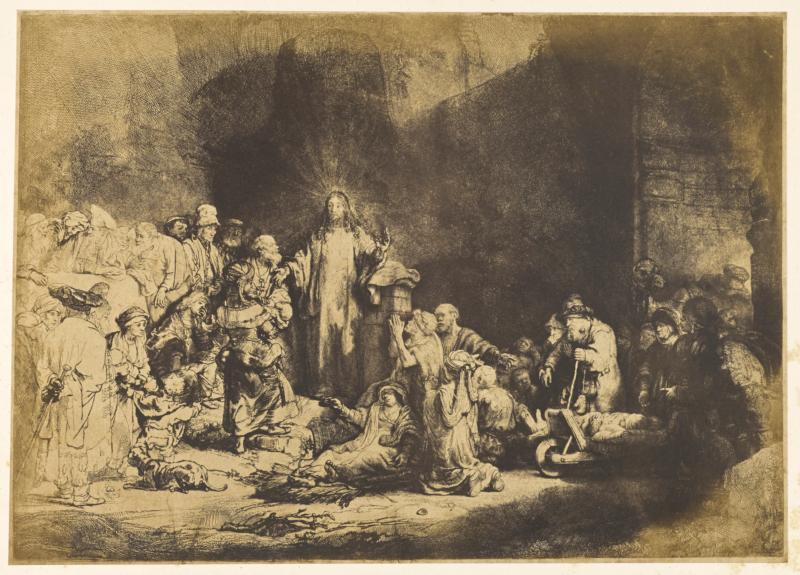
This is a photograph of Rembrandt’s 17th-century etching, “Jesus Christ Healing the Sick.” Although the Gospel writers tell us of many incidents of physical healing accomplished by Jesus, it leaves largely to our imagination the multitude of people who received the grace to carry on valiantly in their suffering or struggles as a result of their encounter with him. (CNS photo/courtesy The J. Paul Getty Museum, Los Angeles)
When we read Scripture, we marvel at the compassion that Jesus showed to the sick and suffering. Often, we read that Jesus was “moved with pity” for the distress of others, and scholars tell us this phrase connotes not just an emotional reaction to their plight, but an empathy so strong that he experiences a physical response.
One can hardly turn a page of the four Gospels without observing Jesus reaching out to the blind, those tormented by demons, those fearing for their children, or to individuals like the man lowered through the roof by his friends or the woman who dared to touch the hem of his garment in hope of healing.
Although the Gospel writers tell us of many incidents of physical healing accomplished by Jesus, it leaves largely to our imagination the multitude of people who received the grace to carry on valiantly in their suffering or struggles as a result of their encounter with him.
[hotblock]
In the church, the sacrament that embodies this beautiful love of Christ for the sick is called the anointing of the sick. This anointing has its roots in the earliest days of the church and the example of Jesus, and along with the sacrament of reconciliation is one of the sacraments of healing.
In the days before the Second Vatican Council, the sacrament of anointing was used more sparingly and was sometimes called “the last rites.”
This has led to the misconception even today that one only receives the beauty and power of this sacrament on one’s deathbed. People often feel life’s end is near if a priest arrives to convey this sacrament to them or their loved one.
Today, the sacrament is encouraged for those facing surgery, suffering a long-term or chronic illness, or experiencing the travails of old age. In many ways, it’s a joyful sacrament. Like those who met Jesus on the road, or saw him passing by, we too can call out with hope and confidence that we will receive his healing touch. We experience the exhilaration of encountering Christ.
Like all the sacraments, the sacrament of anointing is a conduit of grace, that mysterious outpouring of the life of the Spirit.
The Catechism of the Catholic Church says the sacrament is “one especially intended to strengthen those who are being tried by illness” (No. 1511). Strength, courage and comfort are given us through this sacrament, just as Jesus graced people with these gifts on the roads of Palestine.
Jesus himself, through his constant attention to the poor and needy, was no stranger to suffering. His life’s mission led him to his own Passion and painful death. And none of us will be free of suffering in this life.
Through the anointing of the sick, we are reminded that Jesus understands our suffering and that the church, communally, shares with us in our pain.
This sacrament encourages us to unite our suffering to Jesus in his suffering and to our struggling world, and to be offered Christ’s healing strength in return.
***
Caldarola is a freelance writer and a columnist for Catholic News Service.
PREVIOUS: A misunderstood sacrament: Anointing of the sick
NEXT: Anointing of the sick is sacrament for the living



Share this story